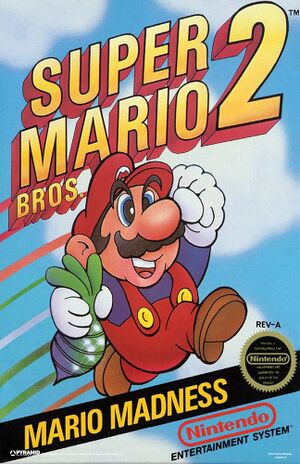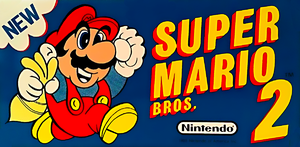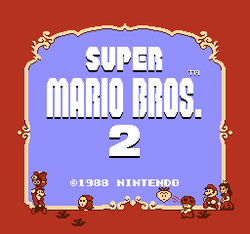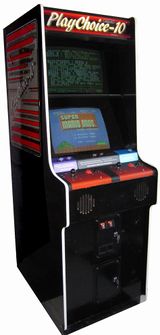Super Mario Bros. 2: Difference between revisions
(add categories) |
(fix category) |
||
| (4 intermediate revisions by the same user not shown) | |||
| Line 25: | Line 25: | ||
==Development== | ==Development== | ||
In 1987, Fuji Television created a special event titled "Dream Factory '87". Fujisankei Communications Group, the company that owns Fuji Television, previously worked with Nintendo in 1986 to create ''[[All Night Nippon Super Mario Bros.]]'', a version of ''Super Mario Bros.'' that contained celebrities, logos, and other objects related to the ''All Night Nippon'' radio program. Fuji Television commissioned Nintendo to create a game based on characters from their "Dream Factory '87" event. | In [[1987]], Fuji Television created a special event titled "Dream Factory '87". Fujisankei Communications Group, the company that owns Fuji Television, previously worked with Nintendo in [[1986]] to create ''[[All Night Nippon Super Mario Bros.]]'', a version of ''Super Mario Bros.'' that contained celebrities, logos, and other objects related to the ''All Night Nippon'' radio program. Fuji Television commissioned Nintendo to create a game based on characters from their "Dream Factory '87" event. | ||
[[Kensuke Tanabe]] and the team at [[Nintendo Entertainment Analysis & Development|Nintendo R&D4]] already had a Mario platforming prototype. The prototype originally had vertical scrolling gameplay and emphasized throwing blocks. [[Shigeru Miyamoto]] suggested to use horizontal scrolling gameplay. When the prototype was expanded into a full game it contained Mario elements, such as the POW block from [[Mario Bros. (video game)|Mario Bros.]] and the [[Starman]] from ''[[Super Mario Bros.]]'' | [[Kensuke Tanabe]] and the team at [[Nintendo Entertainment Analysis & Development|Nintendo R&D4]] already had a Mario platforming prototype. The prototype originally had vertical scrolling gameplay and emphasized throwing blocks. [[Shigeru Miyamoto]] suggested to use horizontal scrolling gameplay. When the prototype was expanded into a full game it contained Mario elements, such as the POW block from [[Mario Bros. (video game)|Mario Bros.]] and the [[Starman]] from ''[[Super Mario Bros.]]'' | ||
| Line 31: | Line 31: | ||
However, the original ''Doki Doki Panic'' contained characters from "Dream Factory '87. The story revolves around a storybook. Twins Poki and Piki were fighting over the last page of the book, and the evil Mamu pulled them into the book. Their family has to venture into the storybook themselves to save them. The brother, Imajin, was average in all areas. Mama could jump high and float for a bit. Lina, Imajin's girlfriend, could hover, but she lacked speed and strength. Papa was the strongest and fastest, but he couldn't jump very high. | However, the original ''Doki Doki Panic'' contained characters from "Dream Factory '87. The story revolves around a storybook. Twins Poki and Piki were fighting over the last page of the book, and the evil Mamu pulled them into the book. Their family has to venture into the storybook themselves to save them. The brother, Imajin, was average in all areas. Mama could jump high and float for a bit. Lina, Imajin's girlfriend, could hover, but she lacked speed and strength. Papa was the strongest and fastest, but he couldn't jump very high. | ||
Nintendo decided not to bring ''Super Mario Bros. 2'' to North America, as they felt that it was too similar to ''Super Mario Bros.'' and would be too hard for North American gamers. Instead, [[Nintendo of America]] localized ''Doki Doki Panic'' so that it would be a ''Super Mario'' game. This game was released in 1988 in North America, Europe and Australia as ''Super Mario Bros. 2''. It was localized in Japan as ''Super Mario USA'' in 1992. Then, when the original ''Super Mario Bros. 2'' was released outside of Japan in 1993, it was titled ''The Lost Levels'' to differentiate it from the game they received as ''Super Mario Bros. 2''. | Nintendo decided not to bring ''Super Mario Bros. 2'' to North America, as they felt that it was too similar to ''Super Mario Bros.'' and would be too hard for North American gamers. Instead, [[Nintendo of America]] localized ''Doki Doki Panic'' so that it would be a ''Super Mario'' game. This game was released in [[1988]] in North America, Europe and Australia as ''Super Mario Bros. 2''. It was localized in Japan as ''Super Mario USA'' in [[1992]]. Then, when the original ''Super Mario Bros. 2'' was released outside of Japan in [[1993]], it was titled ''The Lost Levels'' to differentiate it from the game they received as ''Super Mario Bros. 2''. | ||
==Differences from Doki Doki Panic== | ==Differences from Doki Doki Panic== | ||
| Line 47: | Line 47: | ||
*The white Mouser boss in 5-3 has been changed to a rock-throwing crab named Clawgrip. | *The white Mouser boss in 5-3 has been changed to a rock-throwing crab named Clawgrip. | ||
== | ==Versions of the game== | ||
[[File:super-mario-pc-cabinet.jpg|160px|left]] | [[File:super-mario-pc-cabinet.jpg|160px|left]] | ||
''Super Mario 2'' has been released on many different systems, both through traditional game ports and through [[emulation]] | ''Super Mario 2'' has been released on many different systems, both through traditional game ports and through [[emulation]]. | ||
It was released on the [[Nintendo Entertainment System]] in 1988 in North America, in [[1989]] in Europe and Oceania, and on the Japanese version of the NES, the [[Family Computer]] in [[1992]]. Distributed by [[Mattel]] in Canada, It was one of the sixty games that had a separate release in the country. It also was published by Nintendo in North America, with a cartridge labeled for sale in Canada, Mexico, and the United States. | |||
For coin-operated use, it was released to arcades on the [[PlayChoice-10]] system in 1988. This system allowed play of up to ten NES-based games before the system's timer ran out. | |||
''Super Mario | It was released as an enhanced port for the [[Super Nintendo Entertainment System]] as part of ''[[Super Mario All-Stars]]'' in 1993. A slightly modified port of the ''Super Mario All-Stars'' version was released on the [[Game Boy Advance]] as ''Super Mario Advance'' in [[2001]]. The latter also contained an enhanced remake of ''[[Mario Bros. (video game)|Mario Bros.]]'' | ||
It was released on the [[Nintendo Entertainment System – Nintendo Switch Online]] for [[Nintendo Switch]] service on February 13, 2019. | An emulated version of the NES version was released for the Virtual Console on [[Wii]] in [[2007]]. An emulated version of the SNES version of ''Super Mario All-Stars'' was released as ''Super Mario All-Stars Limited Edition'' on Wii for the 25th anniversary of ''Super Mario Bros.'' in [[2010]]. It was released on the [[Nintendo 3DS]] Virtual Console and on the [[Wii U]] Virtual Console in [[2013]]. | ||
''Super Mario Bros. 2'' was also included as one of the 30 games in the [[NES Classic Edition]] miniature video game console, that emulated NES games and resembled a miniature NES, in [[2016]]. | |||
It was released on the [[Nintendo Entertainment System – Nintendo Switch Online]] for [[Nintendo Switch]] service on February 13, [[2019]]. | |||
[[Category:arcade games]] | [[Category:arcade games]] | ||
[[Category:arcade games developed by Nintendo Research & Development 4]] | [[Category:arcade games developed by Nintendo Research & Development 4]] | ||
| Line 65: | Line 68: | ||
[[Category:arcade games released in 1989]] | [[Category:arcade games released in 1989]] | ||
[[Category:arcade games released on PlayChoice-10]] | [[Category:arcade games released on PlayChoice-10]] | ||
[[Category:Digital items owned by WEC Museum]] | |||
[[Category:Items included in physical compilations owned by WEC Museum]] | |||
[[Category:Luigi]] | |||
[[Category:Mario]] | |||
[[Category:Peach]] | |||
[[Category:Platform games]] | |||
[[Category:Toad]] | |||
[[Category:video games developed by Nintendo Research & Development 4]] | |||
[[Category:Video games developed in Japan]] | |||
[[Category:Video games included in Super Mario All-Stars]] | |||
[[Category:video games published by Nintendo]] | [[Category:video games published by Nintendo]] | ||
[[Category:video games]] | [[Category:video games]] | ||
[[Category:video games released in 1988]] | [[Category:video games released in 1988]] | ||
[[Category:video games released in 1993]] | [[Category:video games released in 1993]] | ||
[[Category:video games released in 2007]] | [[Category:video games released in 2007]] | ||
[[Category:video games released in 2013]] | [[Category:video games released in 2013]] | ||
[[Category:video games released in 2016]] | [[Category:video games released in 2016]] | ||
[[Category:video games released in 2019]] | [[Category:video games released in 2019]] | ||
[[Category:video games released on Nintendo Entertainment System]] | [[Category:video games released on Nintendo Entertainment System in North America]] | ||
[[Category:video games released on Super Nintendo Entertainment System]] | [[Category:video games released on Super Nintendo Entertainment System in Europe]] | ||
[[Category:video games released on | [[Category:video games released on Super Nintendo Entertainment System in North America]] | ||
[[Category:video games released on Virtual Console for Wii]] | [[Category:video games released on Super Nintendo Entertainment System in Oceania]] | ||
[[Category:video games released on Virtual Console for Wii U]] | [[Category:video games released on Virtual Console for Wii worldwide]] | ||
[[Category:video games released on Virtual Console for Nintendo 3DS]] | [[Category:video games released on Virtual Console for Wii U worldwide]] | ||
[[Category:video games released on Virtual Console for Nintendo 3DS worldwide]] | |||
[[Category:video games released on NES Classic Edition]] | [[Category:video games released on NES Classic Edition]] | ||
[[Category:video games released on Nintendo Entertainment System – Nintendo Switch Online]] | [[Category:video games released on Nintendo Entertainment System – Nintendo Switch Online]] | ||
Latest revision as of 18:29, 17 November 2024
This article is about the video game known as Super Mario USA in Japan. For the game known as Super Mario Bros. 2 in Japan, see Super Mario Bros.: The Lost Levels.

| |
| Super Mario Bros. 2 | |
| Developer | Nintendo R&D4 |
|---|---|
| Publisher | Nintendo |
| Platforms | NES, Arcade, SNES, GBA, Wii, 3DS, Wii U, NES Classic Edition, Nintendo Entertainment System – Nintendo Switch Online |
| Released | NES: October 9, 1988 Arcade: 1988 SNES: July 14, 1993 GBA: March 21, 2001 Wii: July 2, 2007 3DS: July 11, 2013 Wii U: May 16, 2013 NES CE: November 10, 2016 Switch Online: February 13, 2019 |
| Added to Museum |
Wii All-Stars: January 20, 2012 NES CE: June 22, 2017 Famicom Mini: August 10, 2017 SNES All-Stars+World: December 19, 2018 |
Super Mario Bros. 2 is known as Super Mario USA in Japan. It is a remake of Dream Factory: Doki Doki Panic (夢工場 ドキドキパニック, Yume Kōjō: Doki Doki Panic), in which the characters from the Fuji Television "Dream Factory '87" event are replaced with characters from the Super Mario series.
Story
Mario and his friends were summoned during their sleep to help in Subcon, the kingdom of dreams. The evil Wart and his minions took over the kingdom and captured the Subcons, the fairy-like creatures that inhabit the dream world.
Thus, Mario, Luigi, Toad, and Princess Toadstool had to travel across seven worlds, defeated Wart's minions, and ultimately defeated Wart himself.
Unfortunately, it wasn't easy as Wart was impervious to physical damage. However, he was able to be hurt if he ingested vegetables. Luckily the Subcon Dream Machine, of which Wart took control, alternated between creating monsters and creating vegetables.
Ingesting four vegetables defeated Wart, freeing the Subcons from the vase in which they were imprisoned, thus finally making Subcon free from the terror of Wart and his cronies.
Development
In 1987, Fuji Television created a special event titled "Dream Factory '87". Fujisankei Communications Group, the company that owns Fuji Television, previously worked with Nintendo in 1986 to create All Night Nippon Super Mario Bros., a version of Super Mario Bros. that contained celebrities, logos, and other objects related to the All Night Nippon radio program. Fuji Television commissioned Nintendo to create a game based on characters from their "Dream Factory '87" event.
Kensuke Tanabe and the team at Nintendo R&D4 already had a Mario platforming prototype. The prototype originally had vertical scrolling gameplay and emphasized throwing blocks. Shigeru Miyamoto suggested to use horizontal scrolling gameplay. When the prototype was expanded into a full game it contained Mario elements, such as the POW block from Mario Bros. and the Starman from Super Mario Bros.
However, the original Doki Doki Panic contained characters from "Dream Factory '87. The story revolves around a storybook. Twins Poki and Piki were fighting over the last page of the book, and the evil Mamu pulled them into the book. Their family has to venture into the storybook themselves to save them. The brother, Imajin, was average in all areas. Mama could jump high and float for a bit. Lina, Imajin's girlfriend, could hover, but she lacked speed and strength. Papa was the strongest and fastest, but he couldn't jump very high.
Nintendo decided not to bring Super Mario Bros. 2 to North America, as they felt that it was too similar to Super Mario Bros. and would be too hard for North American gamers. Instead, Nintendo of America localized Doki Doki Panic so that it would be a Super Mario game. This game was released in 1988 in North America, Europe and Australia as Super Mario Bros. 2. It was localized in Japan as Super Mario USA in 1992. Then, when the original Super Mario Bros. 2 was released outside of Japan in 1993, it was titled The Lost Levels to differentiate it from the game they received as Super Mario Bros. 2.
Differences from Doki Doki Panic
- The storybook aspect was removed, and the land wherein the game takes place was named Subcon rather than Muu.
- The evil villain was now named Wart rather than Mamu.
- Imajin became Mario, Mama became Luigi, Lina became Princess Toadstool, and Papa became Toad.
- It is now possible to press the B button to run.
- You can pick a character to use at the beginning of every level.
- The level introduction screen doesn't show the number of lives remaining unless a life is lost and the level is tried again.
- The leaves that contain vegetables that can be pulled out of the ground are orange instead of black.
- Magic lamps are now magic potions, hearts are now mushrooms, and the big face head is now a turtle shell.
- The mask gate has been changed to a hawk.
- Masks are now mushroom blocks.
- The white Mouser boss in 5-3 has been changed to a rock-throwing crab named Clawgrip.
Versions of the game
Super Mario 2 has been released on many different systems, both through traditional game ports and through emulation.
It was released on the Nintendo Entertainment System in 1988 in North America, in 1989 in Europe and Oceania, and on the Japanese version of the NES, the Family Computer in 1992. Distributed by Mattel in Canada, It was one of the sixty games that had a separate release in the country. It also was published by Nintendo in North America, with a cartridge labeled for sale in Canada, Mexico, and the United States.
For coin-operated use, it was released to arcades on the PlayChoice-10 system in 1988. This system allowed play of up to ten NES-based games before the system's timer ran out.
It was released as an enhanced port for the Super Nintendo Entertainment System as part of Super Mario All-Stars in 1993. A slightly modified port of the Super Mario All-Stars version was released on the Game Boy Advance as Super Mario Advance in 2001. The latter also contained an enhanced remake of Mario Bros.
An emulated version of the NES version was released for the Virtual Console on Wii in 2007. An emulated version of the SNES version of Super Mario All-Stars was released as Super Mario All-Stars Limited Edition on Wii for the 25th anniversary of Super Mario Bros. in 2010. It was released on the Nintendo 3DS Virtual Console and on the Wii U Virtual Console in 2013.
Super Mario Bros. 2 was also included as one of the 30 games in the NES Classic Edition miniature video game console, that emulated NES games and resembled a miniature NES, in 2016.
It was released on the Nintendo Entertainment System – Nintendo Switch Online for Nintendo Switch service on February 13, 2019.


